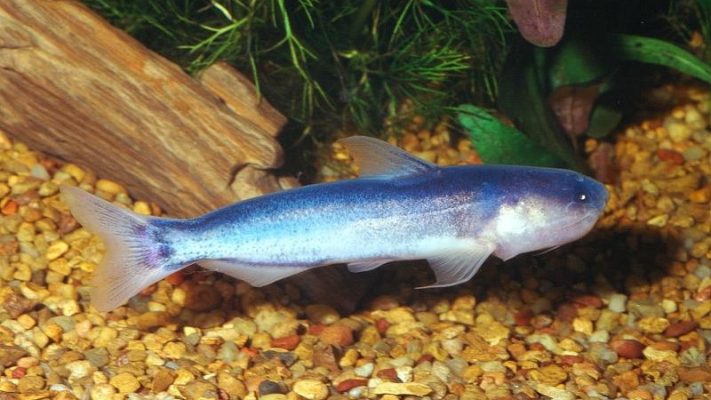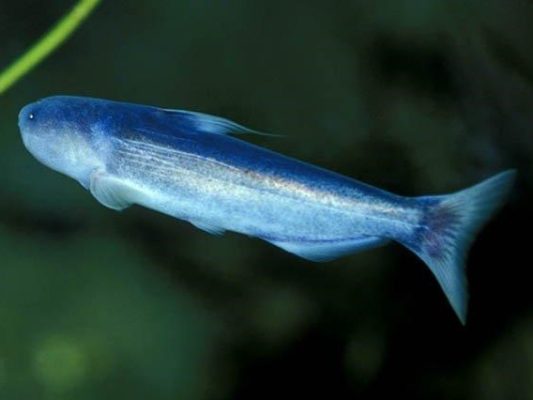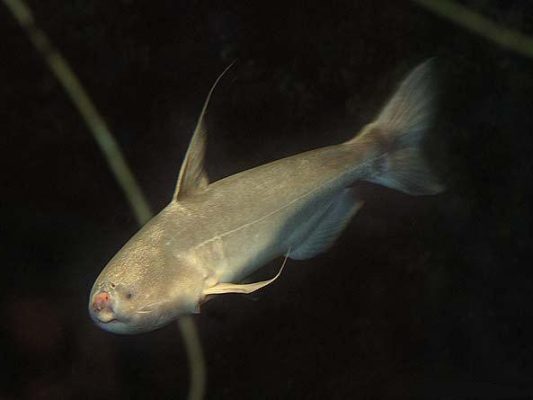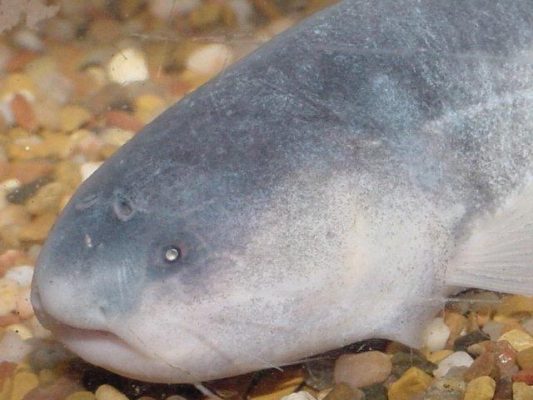Blue Whale Catfish

Table of Contents
- Introduction
- Taxonomy and Classification
- Physical Description
- Distribution and Habitat
- Behavior and Diet
- Reproduction and Life Cycle
- Conclusion
Introduction
The blue whale catfish (Cetopsis coecutiens) is a truly fascinating aquatic species that inhabits the freshwater ecosystems of the Amazon and Orinoco rivers. With its remarkable size and unique characteristics, this species captures the imagination of both scientists and nature enthusiasts alike.
Imagine encountering a catfish that can reach lengths of up to 1.5 meters (5 feet) and weigh over 50 kilograms (110 pounds). The blue whale catfish holds the impressive title of being one of the largest freshwater catfish species in the world. Its sheer size alone is enough to capture the attention of anyone interested in the wonders of the natural world.
In this article, we will delve into the captivating world of the blue whale catfish, exploring its distinctive characteristics, behavior, and conservation status. By the end of this read, you can expect to have a comprehensive understanding of this magnificent species and its crucial role in the aquatic ecosystem.
To fully appreciate the blue whale catfish, it is essential to understand its taxonomic classification within the animal kingdom. This species belongs to the Phylum Chordata, Class Actinopterygii, and Order Siluriformes, commonly known as catfish.
Scientifically known as Cetopsis coecutiens, the blue whale catfish may also be referred to as the “whale catfish” or “giant catfish.” Clear identification is crucial to avoid confusion with other catfish species and ensure accurate scientific research and conservation efforts.
Within the catfish family, the blue whale catfish belongs to the Cetopsidae family, which includes other fascinating species such as the vampire catfish. Its classification highlights its close relationship to other catfish species and its significance within the broader ecosystem of aquatic organisms.
The blue whale catfish boasts an impressive physical presence, characterized by its substantial size and robust body structure. Adults of this species can reach lengths of up to 1.5 meters (5 feet), making it a true giant among freshwater catfish.
Its coloration is another notable feature, with a mottled grayish-brown skin that allows it to blend seamlessly with its surroundings. This camouflage helps the blue whale catfish remain hidden from potential predators and prey alike.
Adaptations play a crucial role in the blue whale catfish’s survival. Its streamlined shape allows for efficient swimming, enabling it to navigate the swift currents of the Amazon and Orinoco rivers. Additionally, the blue whale catfish possesses large, whisker-like barbels that aid in sensory perception, helping it locate food sources and navigate through murky waters.
The blue whale catfish is primarily found in the vast river systems of the Amazon and Orinoco, spanning across several South American countries. Its distribution extends from Brazil and Colombia to Peru and Venezuela, encompassing a significant portion of the continent’s freshwater habitats.
Within these river systems, the blue whale catfish occupies specific habitats that provide the ideal conditions for its survival. Deep river channels, flooded forests, and oxbow lakes are among the preferred habitats where this species can be found.
Environmental factors play a crucial role in determining the blue whale catfish’s distribution. It thrives in water temperatures ranging from 24 to 28 degrees Celsius (75 to 82 degrees Fahrenheit) and requires a pH level of around 6 to 7.5 for optimal survival. Oxygen availability is also a critical factor, as this species relies on well-oxygenated waters to support its respiration.
The blue whale catfish exhibits intriguing behavior patterns that contribute to its survival in the challenging freshwater environments it inhabits. It is primarily nocturnal, meaning it is most active during the nighttime hours when it hunts for prey and avoids potential predators.
As an opportunistic predator, the blue whale catfish has a diverse diet. It feeds on small fish, crustaceans, and insects, taking advantage of the abundant food sources available in its habitat. Its ability to adapt its diet to the available resources ensures its continued survival in ever-changing ecosystems.
Unique behaviors and adaptations further enhance the blue whale catfish’s survival. Its sensory organs, located on its barbels, allow it to navigate through turbid waters and locate prey with remarkable accuracy. This ability to thrive in murky environments sets it apart from other catfish species and showcases its remarkable adaptability.
The reproductive strategies of the blue whale catfish are a fascinating aspect of its life cycle. Breeding season typically occurs during the rainy season, when the river levels rise and create favorable conditions for spawning.
Males engage in courtship rituals to attract females, often competing with other males for the opportunity to mate. Once a female is chosen, she deposits her eggs in hidden locations, such as submerged vegetation or crevices in rocks, to protect them from potential predators.
The life cycle of the blue whale catfish encompasses several stages of growth and development. From birth, the young catfish undergoes significant changes, including the growth of pectoral fins and the development of reproductive organs. These milestones mark its journey towards adulthood and contribute to the overall population dynamics of the species.
Taxonomy and Classification
The blue whale catfish, scientifically known as Cetopsis coecutiens, belongs to the animal kingdom, specifically the phylum Chordata. Within the phylum Chordata, it falls under the subphylum Vertebrata, which includes all animals with a backbone or spinal column. This classification places the blue whale catfish within the broader context of the animal kingdom, highlighting its evolutionary relationship to other vertebrate species.
The scientific name of the blue whale catfish, Cetopsis coecutiens, is derived from Latin and Greek roots. “Cetopsis” refers to its resemblance to cetaceans, the group of marine mammals that includes whales and dolphins. “Coecutiens” translates to “cutting” or “sharp,” which likely refers to the sharp spines present on its dorsal and pectoral fins. These spines serve as a defense mechanism against predators and aid in maneuverability.
In addition to its scientific name, the blue whale catfish may also be referred to by other common names, such as the Amazon whale catfish or the giant catfish. However, it is important to emphasize the use of its scientific name for clear identification and to avoid confusion with other catfish species.
The blue whale catfish belongs to the family Cetopsidae, the order Siluriformes, and the class Actinopterygii. The family Cetopsidae is a diverse group of catfish species found primarily in freshwater habitats, with some species also inhabiting brackish water environments. Within the order Siluriformes, the blue whale catfish is part of a large and diverse group of catfish species, known for their barbels and adaptability to various aquatic habitats.
Furthermore, the class Actinopterygii encompasses all ray-finned fishes, which make up the majority of fish species on Earth. This classification highlights the blue whale catfish’s evolutionary relationship to other fish species and its shared characteristics with other members of the class Actinopterygii.
The blue whale catfish’s taxonomic classification provides valuable insights into its evolutionary history and relationship to other catfish species and aquatic organisms. Understanding its place within the animal kingdom allows researchers and conservationists to better comprehend its ecological role and implement effective conservation strategies.
Physical Description
The blue whale catfish, scientifically known as Cetopsis coecutiens, is an awe-inspiring species that boasts an impressive size and robust body structure. As one of the largest freshwater catfish species, it can grow to remarkable lengths, reaching up to 1.5 meters (5 feet) in size. Its elongated body is cylindrical in shape, tapering towards the tail, which aids in efficient swimming through the water.
One of the most striking features of the blue whale catfish is its unique coloration. Its skin is adorned with a mottled pattern of grayish-brown, resembling the hues of the riverbeds it inhabits. This camouflage allows it to blend seamlessly with its surroundings, providing a natural defense against potential predators. Additionally, this coloration helps the blue whale catfish to ambush its prey, as it can remain hidden until the perfect moment to strike.
The blue whale catfish also possesses large, whisker-like barbels, which are highly sensitive to touch and taste. These barbels, located near its mouth, aid in sensory perception, allowing the catfish to navigate through its environment and locate food sources even in murky waters. These barbels are an essential adaptation that helps the blue whale catfish thrive in its habitat.
The physical characteristics of the blue whale catfish are perfectly suited for its environment, enabling it to adapt and survive in the diverse aquatic ecosystems it calls home. Its streamlined shape, with a tapering body and a powerful tail, allows for efficient movement through the water, minimizing resistance and conserving energy. This streamlined body shape is especially advantageous when the blue whale catfish migrates through deep river channels or flooded forests.
Furthermore, the large barbels play a crucial role in the catfish’s ability to detect prey and navigate its surroundings. By using its barbels to sense vibrations and chemical cues in the water, the blue whale catfish can locate potential food sources, even in low visibility conditions. This sensory perception is vital for its survival, as it allows the catfish to find prey and avoid obstacles or predators.
In summary, the blue whale catfish possesses a remarkable physical description that sets it apart from other aquatic species. Its impressive size and robust body structure, coupled with its mottled grayish-brown skin and large, whisker-like barbels, make it a truly fascinating creature. These physical characteristics not only contribute to its ability to adapt to its environment but also highlight its unique role in the aquatic ecosystem.
Distribution and Habitat
Geographical Distribution:
The blue whale catfish (Cetopsis coecutiens) is primarily found in the vast river systems of South America, with its presence prominently observed in the Amazon and Orinoco rivers. These majestic waterways serve as the primary habitats for this remarkable species, providing them with the ideal conditions for survival and proliferation.
Specific Habitats:
Within these expansive river systems, the blue whale catfish can be found in a variety of specific habitats that cater to their unique needs.
1. Deep River Channels:
Deep river channels, characterized by their swift currents and deeper depths, are favored by the blue whale catfish for their ability to provide ample food sources and protection from predators. These channels serve as highways for these magnificent creatures, allowing them to traverse through the river systems with ease.
2. Flooded Forests (Várzeas):
In addition to deep river channels, the blue whale catfish also thrives in flooded forests. These flooded forests, also known as várzeas, are formed during the rainy season when the rivers overflow their banks, creating a lush and nutrient-rich environment. The blue whale catfish takes advantage of this temporary habitat, utilizing the flooded forests as a feeding ground and refuge.
3. Oxbow Lakes:
Furthermore, oxbow lakes, which are formed when a river changes its course, provide another essential habitat for the blue whale catfish. These lakes are characterized by their calm and stagnant waters, which offer a haven for the catfish to rest and seek shelter. Oxbow lakes also serve as breeding grounds for the blue whale catfish, providing a safe environment for the deposition of their eggs.
Environmental Conditions:
The survival of the blue whale catfish is intricately linked to specific environmental conditions that are vital for their well-being.
1. Water Temperature:
The blue whale catfish thrives in water temperatures ranging from 22 to 28 degrees Celsius (72 to 82 degrees Fahrenheit). These temperatures provide the optimal range for their metabolic processes, ensuring efficient digestion and overall physiological health.
2. pH Levels:
In terms of pH levels, the blue whale catfish prefers slightly acidic to neutral waters, with a pH range of 6.5 to 7.5. This range allows for the maintenance of a healthy internal pH balance, which is crucial for various physiological functions, including enzyme activity and ion regulation.
3. Oxygen Availability:
Oxygen availability is of utmost importance to the blue whale catfish, as they are obligate air breathers. While they primarily extract oxygen from the water through their gills, they also possess a specialized labyrinth organ that allows them to extract oxygen directly from the air. This unique adaptation enables them to survive in oxygen-deprived environments, such as stagnant pools or areas with low water circulation.
In conclusion, the blue whale catfish is distributed across the Amazon and Orinoco rivers, with specific habitats including deep river channels, flooded forests, and oxbow lakes. The environmental conditions that favor their survival include water temperatures of 22 to 28 degrees Celsius, pH levels ranging from 6.5 to 7.5, and adequate oxygen availability. Understanding the distribution and habitat preferences of this remarkable species is crucial for conservation efforts and ensuring the preservation of their unique ecological niche in the South American river systems.
Behavior and Diet
The blue whale catfish, also known as Cetopsis coecutiens, exhibits fascinating behavior patterns that contribute to its survival in its aquatic habitat. One notable behavior is its nocturnal nature, as it is primarily active during the night. This behavior allows the blue whale catfish to avoid predators and take advantage of the cover of darkness to hunt for prey undisturbed.
When it comes to diet, the blue whale catfish is an opportunistic predator, consuming a variety of prey items. Its diet primarily consists of small fish, crustaceans, and insects. Equipped with a wide mouth and sharp teeth, the blue whale catfish efficiently captures and consumes its prey. It is an adept hunter, using its well-developed sensory organs to detect vibrations and movements in the water, allowing it to locate and capture prey with precision.
One unique behavior and adaptation of the blue whale catfish is its ability to navigate through murky waters using its sensory organs. In environments with low visibility, such as muddy rivers or flooded forests, the blue whale catfish relies on its highly sensitive barbels to detect changes in water pressure and chemical signals. These barbels, located around its mouth, act as sensory organs, providing the blue whale catfish with crucial information about its surroundings.
Furthermore, the blue whale catfish has a specialized organ called the Weberian apparatus, which enhances its hearing capabilities. This adaptation allows the blue whale catfish to detect faint sounds and vibrations in the water, aiding in locating prey and avoiding potential threats.
Additionally, the blue whale catfish has a streamlined body shape, enabling it to move swiftly through the water. This adaptation is particularly useful when pursuing prey or evading predators. Its muscular body and strong pectoral fins provide the necessary power and maneuverability for efficient swimming.
Overall, the behavior and adaptations of the blue whale catfish highlight its remarkable ability to thrive in its aquatic environment. Its nocturnal nature, diverse diet, and sensory adaptations contribute to its success as a predator. Understanding these behaviors and adaptations not only provides insight into the ecological role of the blue whale catfish but also underscores the importance of preserving its habitat and ensuring its long-term survival.
As researchers continue to study the behavior and adaptations of the blue whale catfish, further discoveries may shed light on its unique characteristics and contribute to the broader understanding of aquatic ecosystems. By protecting and conserving this species, we can help maintain the delicate balance of our planet’s rivers and lakes, ensuring the survival of not only the blue whale catfish but also the diverse array of aquatic life that relies on these habitats.
Reproduction and Life Cycle
Reproductive Strategies of the Blue Whale Catfish
The blue whale catfish, scientifically known as Cetopsis coecutiens, exhibits fascinating reproductive strategies that ensure the continuation of its species. Similar to many other catfish species, the blue whale catfish has a specific breeding season and engages in courtship rituals to attract mates.
During the breeding season, which typically occurs during the rainy season when water levels rise, male blue whale catfish become more active in their pursuit of females. They engage in elaborate courtship displays to attract the attention of potential mates. These displays often involve showcasing their physical prowess and dominance over other males.
Mating Rituals and Courtship Behaviors
Once a male blue whale catfish successfully attracts a female, they engage in intricate mating rituals. These rituals often involve aggressive behaviors, with males competing fiercely for the opportunity to mate with the female. They may engage in territorial disputes and physical contests, such as pushing and shoving, to establish dominance and secure their position as the chosen mate.
After a successful courtship, the female blue whale catfish deposits her eggs in hidden locations within the aquatic environment. These hidden locations, such as crevices or submerged vegetation, provide protection for the eggs from potential predators. The female takes great care in selecting suitable locations to ensure the survival of her offspring.
Life Cycle Stages and Notable Milestones
The life cycle of the blue whale catfish encompasses several stages, each marked by notable milestones and changes. After the female deposits her eggs, the male fertilizes them externally. The eggs then undergo a period of incubation, which can vary depending on environmental conditions such as water temperature and oxygen levels.
Once the eggs hatch, the blue whale catfish larvae emerge. At this stage, they are highly vulnerable and rely on their yolk sac for nourishment. As they grow, they develop pectoral fins, which aid in their movement and navigation within their aquatic habitat. The growth of these fins is a significant milestone in their development.
As the blue whale catfish continues to mature, it undergoes various physiological changes. Notably, the development of reproductive organs marks a crucial milestone in its life cycle. This development enables the blue whale catfish to reach sexual maturity and participate in the reproductive process, ensuring the continuation of the species.
Throughout its life cycle, the blue whale catfish faces various challenges and environmental factors that can impact its survival. Understanding these stages and milestones is essential for conservation efforts and the preservation of this unique species.
In conclusion, the blue whale catfish exhibits fascinating reproductive strategies, including specific breeding seasons, courtship rituals, and competitive mating behaviors. The life cycle of the blue whale catfish encompasses various stages, each marked by notable milestones and changes. By studying and understanding these reproductive and life cycle processes, we can contribute to the conservation and preservation of this ecologically significant species.
Conclusion
The blue whale catfish (Cetopsis coecutiens) is a remarkable aquatic species that plays a crucial role in maintaining the balance of the aquatic ecosystem. Throughout this article, we have explored the unique characteristics, behavior, and conservation status of this fascinating creature.
In summary, the blue whale catfish is one of the largest freshwater catfish species, captivating us with its impressive size and robust body structure. Its mottled grayish-brown skin and large whisker-like barbels are distinctive physical features that aid in its adaptation to the environment. These physical characteristics, such as its streamlined shape and sensory perception through barbels, enable the blue whale catfish to thrive in its habitat.
The geographical distribution of the blue whale catfish spans the Amazon and Orinoco rivers, where it can be found in deep river channels, flooded forests, and oxbow lakes. It is well-suited to survive in these habitats, with favorable environmental conditions such as specific water temperature, pH levels, and oxygen availability.
The behavior of the blue whale catfish is intriguing, as it exhibits nocturnal tendencies and leads a solitary lifestyle. Its diet consists of small fish, crustaceans, and insects, showcasing its role as a top predator in the aquatic ecosystem. Furthermore, its unique ability to navigate through murky waters using its sensory organs contributes to its survival.
Reproduction in the blue whale catfish involves specific breeding seasons and courtship rituals, with males competing for females and the deposition of eggs in hidden locations. The life cycle stages, from birth to adulthood, entail notable milestones such as the growth of pectoral fins and the development of reproductive organs.
However, the blue whale catfish faces numerous threats and challenges that jeopardize its survival. Habitat loss due to deforestation and dam construction, as well as human activities like overfishing and pollution, pose significant risks to its population. It is crucial that we recognize the importance of this species and take action to protect it.
Further research and conservation efforts are essential to ensure the survival of the blue whale catfish. Scientific studies on its feeding behavior, genetic diversity, and overall ecological significance provide valuable insights into aquatic ecosystems. These findings can inform habitat restoration projects and conservation policies, contributing to the preservation of biodiversity.
In conclusion, the blue whale catfish is a species of immense importance in maintaining the delicate balance of the aquatic ecosystem. Its unique characteristics, behavior, and ecological significance highlight the need for continued research and conservation efforts. We must appreciate and protect the diverse aquatic life in our planet’s rivers and lakes, ensuring the survival of not only the blue whale catfish but also the countless other species that depend on these ecosystems for their existence. Let us take action now to safeguard the future of our precious natural heritage.



